Arm's Cortex-A76 CPU Unveiled: Taking Aim at the Top for 7nm
by Andrei Frumusanu on May 31, 2018 3:01 PM EST- Posted in
- CPUs
- Arm
- Smartphones
- Mobile
- SoCs
- Cortex-A76
Cortex A76 µarch - Backend
Switching to the back-end of the core we have a look at the execution core.
The integer core contains 6 issue queues and execution ports (4 depicted in the slide plus 2 load/store pipelines). There are 3 integer execution pipelines – two ALUs capable of simple arithmetic operations and a complex pipeline handling also multiplication, division and CRC ops. The three integer pipelines are served by 16 deep issue queues. The same size issue queue can also be found serving the single branch execution port.
Two load/store units are the remaining ports of the integer core and are each served by two 12 deep issue queues. The issue queue stages are 3 cycles deep and while I mentioned that the rename/dispatch is 1 stage deep, the dispatch stage actually overlaps with the first cycle of the issue queues stages.
The ASIMD/floating point core contains two pipelines which are served by two 16-deep issue queues.
When it comes to the backend of a CPU core the two most important metrics are instruction throughput and latency. Where the A76 in particular improves a lot is in terms of instruction latency as it’s able to shave off cycles on very important instructions.
To better overview the improvements I created a table with the most common instruction types. The execution throughput and latencies presented here are for AArch64 instructions and if not otherwise noted represent operations on 64-bit data for integer and 64bit (double precision) FP.
| Backend Execution Throughput and Latency | ||||||
| Cortex-A75 | Cortex-A76 | Exynos-M3 | ||||
| Exec | Lat | Exec | Lat | Exec | Lat | |
| Integer Arithmetic (Add, sub) | 2 | 1 | 3 | 1 | 4 | 1 |
| Integer Multiply 32b | 1 | 3 | 1 | 2 | 2 | 3 |
| Integer Multiply 64b | 1 | 3 | 1 | 2 | 1 (2x 0.5) |
4 |
| Integer Multiply Accumulate | 1 | 3 | 1 | 2 | 1 | 3 |
| Integer Division 32b | 0.25 | 12 | 0.2 | < 12 | 1/12 - 1 | < 12 |
| Integer Division 64b | 0.25 | 12 | 0.2 | < 12 | 1/21 - 1 | < 21 |
| Move (Mov) | 2 | 1 | 3 | 1 | 3 | 1 |
| Shift ops (Lsl) | 2 | 1 | 3 | 1 | 3 | 1 |
| Load instructions | 2 | 4 | 2 | 4 | 2 | 4 |
| Store instructions | 2 | 1 | 2 | 1 | 1 | 1 |
| FP Arithmetic | 2 | 3 | 2 | 2 | 3 | 2 |
| FP Multiply | 2 | 3 | 2 | 3 | 3 | 4 |
| FP Multiply Accumulate | 2 | 5 | 2 | 4 | 3 | 4 |
| FP Division (S-form) | 0.2-0.33 | 6-10 | 0.66 | 7 | >0.16 (2x 1+/12) |
12 |
| FP Load | 2 | 5 | 2 | 5 | 2 | 5 |
| FP Store | 2 | 1-N | 2 | 2 | 2 | 1 |
| ASIMD Arithmetic | 2 | 3 | 2 | 2 | 3 | 1 |
| ASIMD Multiply | 1 | 4 | 1 | 4 | 1 | 3 |
| ASIMD Multiply Accumulate | 1 | 4 | 1 | 4 | 1 | 3 |
| ASIMD FP Arithmetic | 2 | 3 | 2 | 2 | 3 | 2 |
| ASIMD FP Multiply | 2 | 3 | 2 | 3 | 1 | 3 |
| ASIMD FP Chained MAC (VMLA) | 2 | 6 | 2 | 5 | 3 | 5 |
| ASIMD FP Fused MAC (VFMA) | 2 | 5 | 2 | 4 | 3 | 4 |
On the integer operations side the A76 improves the multiplication and multiply accumulate latencies from 3 cycles down to 2 cycles, with the throughput remaining the same when compared to the A75. Obviously because the A76 has 3 integer pipelines simple arithmetic operations see a 50% increase in throughput versus the A75’s 2 pipelines.
The much larger and important improvements can be found in the “VX” (vector execution) pipelines which are in charge of FP and ASIMD operations. Arm calls the new pipeline a “state-of-the-art” design and this is finally the result that’s been hyped up for several years now.
Floating point arithmetic operations have been reduced in latency from 3 cycles down to 2 cycles, and multiply accumulate has also shaved off a cycle from 5 cycles down to 4.
What Arm means by the “Dual 128bit ASIMD” with doubled execution bandwidth is that for the A75 and prior only one of the vector pipelines was capable of 128bit while the other one was still 64-bit. For the A76 both vector pipelines are 128-bit now so quad-precision operations see a doubling of the execution throughput.
Moving onto more details of the data handling side, we see the again the two load/store pipelines which was something first implemented on the A73 and A75. Although depicted as one issue queue in the slide, the LD/S pipelines each have their own queues at 16 entries deep.
The data cache is fixed at 64KB and is 4-way associative. Load latency remains at 4 cycles. The DTLBs run a separate pipeline as tag and data lookup. Arm’s goals here is aiming for maximum MLP/ memory level parallelism to be able to feed the core.
In a perfect machine everything would be already located in the caches, so it’s important to have very robust prefetching capabilities. On the A76 we see a new 4th generation prefetchers introduced to get nearer to this goal of perfect cache-hit operation. In all the A76 has 4 different prefetching engines running in parallel looking at various data patterns and loading data into the caches.
In terms of the A76 cache hierarchy Arm is said to have made no compromises and got the best of both worlds in terms of bandwidth and latency. The 64KB L1 instruction cache reads up to 32B/cycle and the same bandwidth applies to the L1 data cache in both directions. The L1 is a writeback cache. The L2 cache is configurable in 256 or 512KB sizes and is D-side inclusive with the same 2x 32B/cycle write and read interfaces up to the exclusive L3 cache in the 2nd generation DSU.
Overall the microarchitectural improvements on the core are said to improve memory bandwidth to DRAM by up to 90% in microbenchmarks.
All in all the microarchitecture of the A76 could be summed up in a few focus design points: Maximise memory performance throughout the core by looking at every single cycle. During the design phase the engineers were looking at feature changes with a sensitivity of up to 0.25% in performance or power – if that metric was fulfilled then it was deemed to be a worthwhile change in the core. Small percentages then in turn add up to create significant figures in the end product.
The focus on bandwidth on latency is said to have been extreme, and Arm was very adamant in re-iterating that to be able to take full advantage of the microarchitecture that vendors need to implement an equally capable memory subsystem on the SoC to see full advantages. A figure that was put out there was 0.25% of performance per nanosecond of latency to main memory. As we’ve seen in the Snapdragon 845 one of the reasons the SoC didn’t quite reach Arm’s projected performance metrics was the degraded memory latency figures which might have been introduced by the L4 system cache in the SoC. In the future vendors will need to focus more on providing latency sensitive memory subsystems as otherwise they’ll be letting free performance and power on the table with differences that could amount to basically a generational difference in CPU IP.


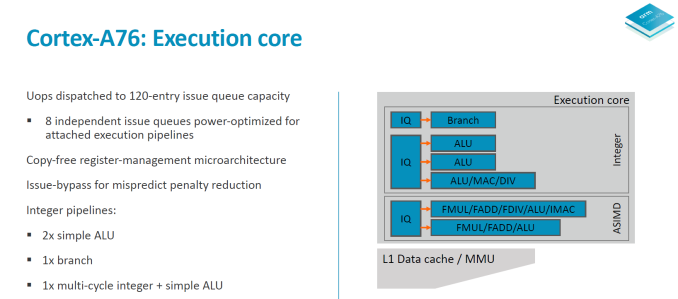
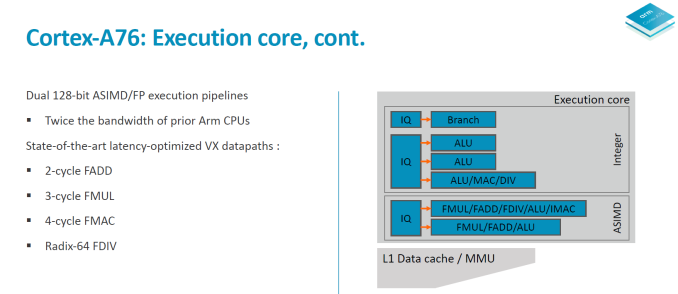
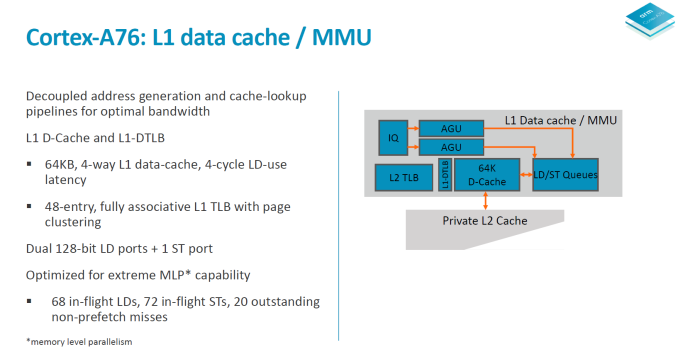
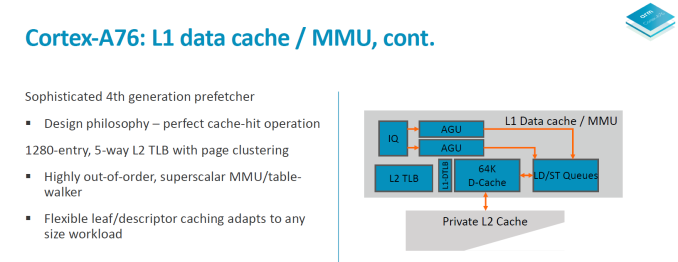
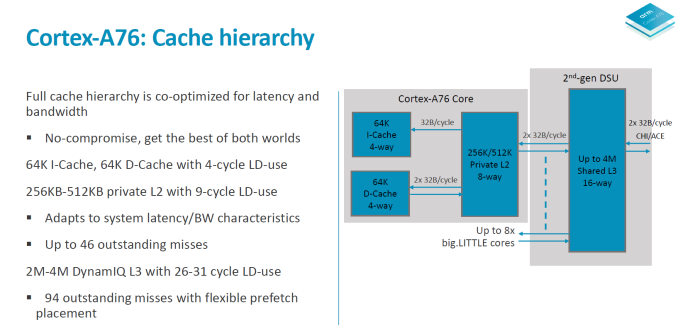
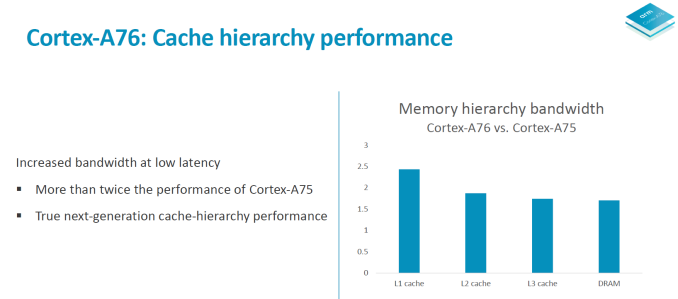








123 Comments
View All Comments
leo_sk - Sunday, June 3, 2018 - link
They had many problems other than target audience. I can give one plus as a counter exampleMatthmaroo - Monday, June 4, 2018 - link
Also Apple has gigantic RD budgetsThink Intel / Qualcomm and AMD are a faction of Apple is size
Matthmaroo - Monday, June 4, 2018 - link
Edit “is” should be ApplesAnd add ARM holding to the list of cpu developers
BillBear - Friday, June 1, 2018 - link
We know from TSMC that moving the A12 to their 7nm process will give Apple some significant improvements before we even consider this year's improvements to their design.>Compared to its 10nm FinFET process, TSMC's 7nm FinFET features 1.6X logic density, ~20% speed improvement, and ~40% power reduction.
http://www.tsmc.com/english/dedicatedFoundry/techn...
joms_us - Friday, June 1, 2018 - link
Nonsense, GB was designed to interpolate scores from worthless tasks that don't mean to real-world scenarios. Even iPhone with A11 is no match in speed and performance versus SD845 and Exynos powered Android phones today. You only use GB to compare two similar platform period. There is no way in hell A11 is faster than Skylake or Ryzen. Only ret@rded people will believe on that.BillBear - Friday, June 1, 2018 - link
>GB was designed to interpolate scores from worthless tasksGeekbench borrows code from popular open source projects and benchmarks that code running against the same workload on multiple platforms.
For instance, Google's open sourced code to render HTML and DOM in Chrome, Google's code to render PDFs in Chrome, the open sourced LLVM compiler Google now builds the Windows version of Chrome with.
Hardly worthless.
joms_us - Friday, June 1, 2018 - link
Oh yeah rendering html, see any speed tests, SD845 phone loads faster than iPhone 8/X. SD845 exports video faster than A11. See my point, just because A9 loads one piece of the whole feature, doesn't mean it it has faster single core than even SD820 which used to have higher score than A9 using prev GB version. See the point? They rigged the scoring system so it would appear Apple SoC is much faster than even Intel or AMD processors LOL.name99 - Friday, June 1, 2018 - link
Comparing Apple cores to Intel for browsers gives the same results as GeekBench.My personal comparisons of Wolfram Player on iPad Pro vs MacBook Pro again confirm GB4 results.
Back when we had SPEC2006 numbers for Apple cores, YET AGAIN they confirmed the GB4 results...
If you don't believe the browser results, nothing is stopping you from running something like jetstream on your own devices (and borrowing someone's iPad Pro or iPhone X, since I assume you wouldn't be caught dead owning one).
https://www.browserbench.org/JetStream/
joms_us - Friday, June 1, 2018 - link
Good now load a similar app and website at the same time on iPhone X and AMD or Intel desktop and come back here. Even SD835 slaughtered the A11 on a side by side comparisons. Again the point is, they multiplied the scores on where Apple SoC is faster by nanosec and call it twice faster than competiton LOL. As if nanosec is noticeable in real life scenario =Dlostmsu - Tuesday, June 5, 2018 - link
You are being unreasonable. Run JetStream on any of your SD8XX devices, and let parent run it on A11, and let's see. Nobody's going to trust your word here against a reasonable suggestion.